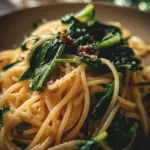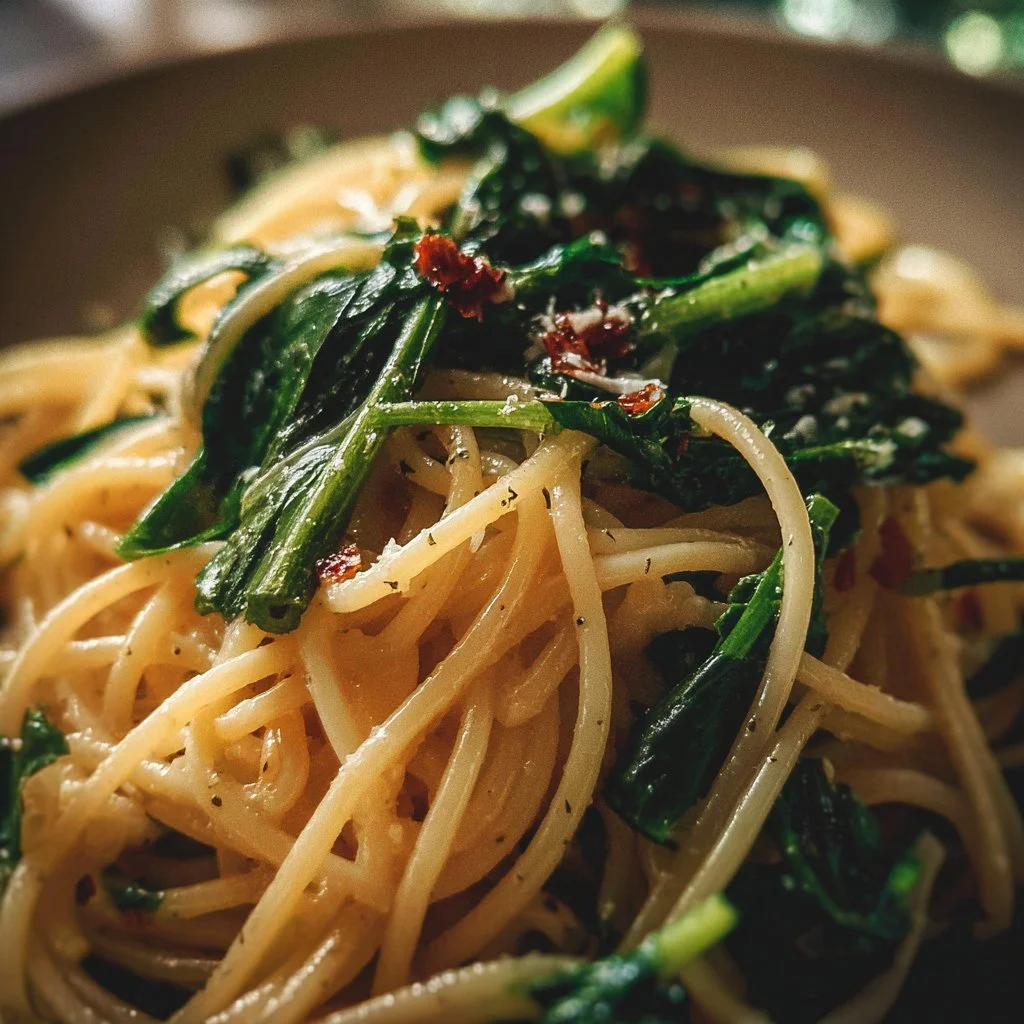Spaghetti with ramps offers a delightful and seasonal culinary experience. This rustic dish showcases the unique flavor of ramps, which are often called wild leeks. Their mild oniony taste and green, leafy presence bring a fresh twist to your classic spaghetti. You’ll find that the combination of the tender pasta and fragrant ramps creates a dish that is simple yet full of character, perfect for both casual dinners and more festive occasions.
Why We Love This Spaghetti with Ramps Recipe
What makes this spaghetti with ramps truly special is its simplicity. You don’t need a vast array of ingredients to enjoy a delightful meal; just a handful of fresh components creates a rich flavor profile. The ramps add an earthy quality, elevating the dish above traditional pasta recipes. Plus, preparing spaghetti with ramps is quick and easy, making it perfect for weeknight dinners or impressing guests with minimal effort. The interplay between the savory and mildly pungent ramps and the comforting pasta is a match made in heaven.
Ingredients about Spaghetti with Ramps
- 1 (16 ounce) package spaghetti
- 1 tablespoon olive oil
- 0.5 bunch ramps – leaves washed, dried, and finely chopped
- Salt, to taste
- Freshly ground black pepper, to taste
- 1 tablespoon freshly grated Parmesan cheese, or to taste
These ingredients are straightforward and commonly found in many pantries. The focus on fresh ramps provides a seasonal flair that enhances the overall taste of your meal.
How to Make Spaghetti with Ramps Directions
To prepare your spaghetti with ramps, start by filling a large pot with lightly salted water. Bring this water to a boil over high heat. The salt will help enhance the flavor of the spaghetti as it cooks. Once the water is at a rolling boil, add your spaghetti, cooking it according to package instructions, typically around 12 minutes, until it reaches that perfect al dente texture.
While the pasta cooks, take out a skillet and pour in the olive oil. Set it over low heat to warm up gently. As the olive oil heats, chop your ramps finely, making sure to wash and dry the leaves thoroughly beforehand. After a few minutes, add the chopped ramps to the skillet. Sauté them gently for around 3 to 5 minutes, allowing their flavors to infuse into the oil. They should become slightly tender but retain some crunch.
Once the spaghetti finishes cooking, reserve about 1/4 cup of the starchy pasta water before draining the pasta. This water will be essential for creating a luscious sauce. Combine the drained spaghetti with the sautéed ramps in the skillet. Pour in the reserved pasta water little by little, mixing everything together until a light sauce forms. The water helps to bind the pasta with the ramps, creating a silky finish.
Season your dish with salt and freshly ground black pepper to taste. Don’t shy away from this step; the right amount of seasoning can elevate your dish considerably. Just before serving, sprinkle the freshly grated Parmesan cheese on top. This cheese adds a salty nuance that contrasts beautifully with the earthy ramps. Enjoy your dish while it’s hot, savoring the unique combination of flavors.
How to Serve Spaghetti with Ramps
Serving your spaghetti with ramps is as easy as it is rewarding. Use large, warmed plates to showcase the vibrant colors of your dish. You can serve it family-style, placing the entire skillet in the middle of the table for everyone to help themselves. Alternatively, portion out the pasta onto individual plates, allowing guests to admire the arrangement before diving in.
Feel free to add extra toppings if you desire. A sprinkle of additional Parmesan on top can enhance the flavor, while a few freshly cracked black peppercorns can add extra depth. For a more colorful presentation, consider garnishing with a few whole ramps or fresh parsley. Serve your spaghetti with ramps alongside a crisp green salad or some crusty bread to soak up any leftover sauce, making the meal more complete.
Expert Tips: Spaghetti with Ramps
- Choose Fresh Ramps: When selecting ramps, look for firm, vibrant leaves without any browning. Fresh ramps offer the best flavor, making your dish more enjoyable.
- Adjust Cooking Time for Pasta: The ideal texture for spaghetti is al dente, which means firm to the bite. Keep an eye on your pasta, as cooking times may vary slightly depending on your stove and the specific brand of spaghetti used.
- Play with Texture: If you enjoy a bit more crunch, consider reserving a few ramps and adding them raw as a garnish on top of the cooked dish. This way, you’ll experience both cooked and raw ramp flavors.
- Experiment with Cheese: If you’re not a fan of Parmesan, feel free to swap it out for another cheese that complements pasta well, like Pecorino Romano or a nutty Grana Padano.
- Pasta Water is Key: The reserved pasta water is crucial for achieving the right sauce consistency. If you find your dish too dry, don’t hesitate to add more pasta water little by little until you reach your desired consistency.
How to Store Spaghetti with Ramps
To store leftover spaghetti with ramps, allow it to cool to room temperature. Then, place the pasta in an airtight container, ensuring it is sealed properly to maintain its freshness. It can be refrigerated for up to three days; after that, the ramps may lose their flavor and texture.
When you’re ready to enjoy the leftovers, reheat the pasta gently on the stove over low heat, adding a splash of water or olive oil to help revive the sauce. You can also use the microwave for a quick reheating, but be mindful not to scald it. Stir the pasta halfway through to ensure it warms evenly.
Variation of Spaghetti with Ramps
This recipe is wonderfully versatile, allowing you to customize it according to your preferences. For a delightful twist, try adding a protein such as grilled chicken or sautéed shrimp for a heartier dish. Simply cook the protein separately, then toss it in with the pasta and ramps during the final mixing.
If you’re looking for a vegetarian-friendly variety, consider incorporating seasonal vegetables like asparagus or spinach. Sauté these alongside the ramps for a more complex flavor and additional nutrition.
For those who love some heat, a pinch of red pepper flakes can add a nice kick to the dish. Conversely, if you’re looking to reduce the richness, you can skip the cheese entirely or use a light alternative.
FAQ
What are ramps, and how do they taste?
Ramps are wild leeks that feature a unique flavor profile combining the sweetness of onions and the earthiness of garlic. They add a distinctive taste to dishes, particularly pasta.
Can I use dried ramps instead of fresh ones for spaghetti?
While fresh ramps are preferred for their flavor, using dried ramps can be an alternative if fresh ones are hard to find. However, the flavor intensity will differ, so adjust the amount used accordingly.
Is spaghetti with ramps a filling dish?
Yes, spaghetti with ramps is a satisfying meal on its own, thanks to the combination of pasta and the heartiness of the ramps. Pair it with a side salad for a complete dining experience.
How can I make this recipe vegetarian?
The included ingredients in spaghetti with ramps are naturally vegetarian. Just be sure to use a vegetarian Parmesan cheese or choose to omit the cheese entirely, focusing on the savory ramp flavor.
How long does it take to make spaghetti with ramps?
You can prepare this delightful dish in about 20 to 30 minutes from start to finish, making it a quick option for busy weeknight dinners or a last-minute gathering.

Spaghetti with Ramps
Ingredients
Pasta and Ramps
- 1 package 16 ounce package spaghetti
- 0.5 bunch ramps - leaves washed, dried, and finely chopped
Sauce and Seasoning
- 1 tablespoon olive oil Use for sautéing the ramps
- to taste Salt Add to the water for cooking pasta and for seasoning
- to taste Freshly ground black pepper
- 1 tablespoon freshly grated Parmesan cheese Additional can be added to taste
Instructions
Cooking Pasta
- Fill a large pot with lightly salted water and bring to a boil over high heat.
- Once boiling, add the spaghetti and cook according to package instructions, typically around 12 minutes until al dente.
Sautéing Ramps
- While the pasta cooks, heat olive oil in a skillet over low heat.
- Finely chop the cleaned ramps.
- Add the chopped ramps to the skillet and sauté for 3 to 5 minutes until tender but still slightly crunchy.
Combining Ingredients
- Reserve about 1/4 cup of pasta water before draining the spaghetti.
- Combine the drained spaghetti with the sautéed ramps in the skillet.
- Add reserved pasta water gradually, mixing until a light sauce forms.
- Season with salt and freshly ground black pepper to taste.
- Sprinkle the freshly grated Parmesan cheese on top before serving.
Serving
- Serve the spaghetti on warmed plates, family-style or individually.
- Consider extra toppings like more Parmesan or fresh parsley for presentation.
Send me this recipe!
Just enter your email below and get it sent straight to your inbox!


